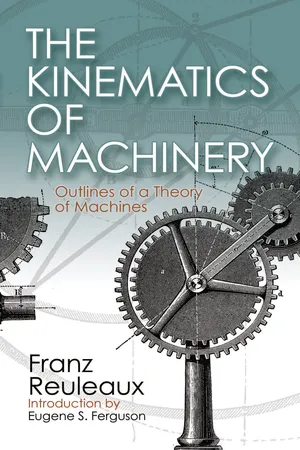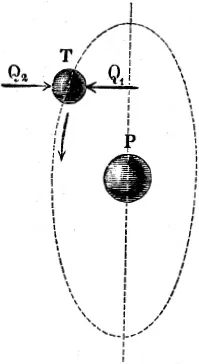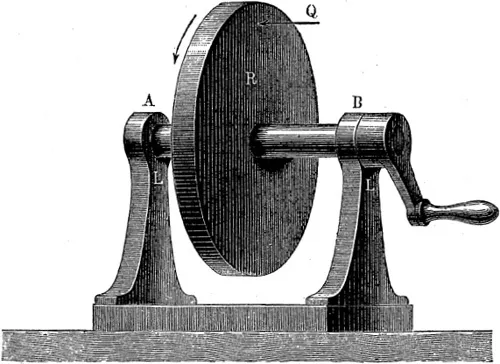
eBook - ePub
The Kinematics of Machinery
Outlines of a Theory of Machines
- 640 pages
- English
- ePUB (mobile friendly)
- Available on iOS & Android
eBook - ePub
About this book
This classic work explores the kinematics of machinery, chronicling the discovery and application of principles underlying the controlled movements within machines. Franz Reuleaux, the Father of Kinematics, writes with authority and precision about his original and incisive ideas, which have endured for more than a century.
Developing the subject from its fundamentals, Reuleaux begins with a discussion of the nature of the machine problem. He advances to examinations of such topics as phoronomic propositions, pairs of elements, incomplete kinematic chains and notation, analysis of chamber-crank trains and complete machines, kinematic synthesis, and related subjects. More than 450 figures illustrate his descriptions. An excellent text for basic courses in kinematics, this volume also serves as a standard reference for professionals.
Developing the subject from its fundamentals, Reuleaux begins with a discussion of the nature of the machine problem. He advances to examinations of such topics as phoronomic propositions, pairs of elements, incomplete kinematic chains and notation, analysis of chamber-crank trains and complete machines, kinematic synthesis, and related subjects. More than 450 figures illustrate his descriptions. An excellent text for basic courses in kinematics, this volume also serves as a standard reference for professionals.
Frequently asked questions
Yes, you can cancel anytime from the Subscription tab in your account settings on the Perlego website. Your subscription will stay active until the end of your current billing period. Learn how to cancel your subscription.
No, books cannot be downloaded as external files, such as PDFs, for use outside of Perlego. However, you can download books within the Perlego app for offline reading on mobile or tablet. Learn more here.
Perlego offers two plans: Essential and Complete
- Essential is ideal for learners and professionals who enjoy exploring a wide range of subjects. Access the Essential Library with 800,000+ trusted titles and best-sellers across business, personal growth, and the humanities. Includes unlimited reading time and Standard Read Aloud voice.
- Complete: Perfect for advanced learners and researchers needing full, unrestricted access. Unlock 1.4M+ books across hundreds of subjects, including academic and specialized titles. The Complete Plan also includes advanced features like Premium Read Aloud and Research Assistant.
We are an online textbook subscription service, where you can get access to an entire online library for less than the price of a single book per month. With over 1 million books across 1000+ topics, we’ve got you covered! Learn more here.
Look out for the read-aloud symbol on your next book to see if you can listen to it. The read-aloud tool reads text aloud for you, highlighting the text as it is being read. You can pause it, speed it up and slow it down. Learn more here.
Yes! You can use the Perlego app on both iOS or Android devices to read anytime, anywhere — even offline. Perfect for commutes or when you’re on the go.
Please note we cannot support devices running on iOS 13 and Android 7 or earlier. Learn more about using the app.
Please note we cannot support devices running on iOS 13 and Android 7 or earlier. Learn more about using the app.
Yes, you can access The Kinematics of Machinery by Franz Reuleaux, Eugene S. Ferguson in PDF and/or ePUB format, as well as other popular books in Technology & Engineering & Mechanical Engineering. We have over one million books available in our catalogue for you to explore.
Information
CHAPTER I.
GENERAL OUTLINES.
§ 1.
Nature of the Machine-Problem.
WHILE in appearance a machine differs greatly from any of the force- or motion-distributors of nature, yet for the theoretical or pure mechanician no such difference exists,—or rather it completely disappears on analysis, so that to him the problems of machinery fall into the same class as those of the mechanical phenomena of nature. He sees in both forces and motions existing, and subject to the same great laws which, developed in their most general form, govern and must govern every single case. In pure Mechanics machines are now treated only as illustrations; they no longer receive their complete development as they did when many of their problems were still new and strange, and apparently stood opposed to those of Mechanics. This present subdivision is quite correct, so far as the question is one of scientific comprehension only. As, however, the actual machinery itself, deriving its existence from various sources, and having its own characteristic features and methods of classification and treatment, forms a quite distinct and special subject, a separation of its scientific mechanical problems from those of Mechanics in general is possible, and indeed has already been made.
It must be admitted, too, that the sense of the reality of this separation has been felt not only by Engineers or others actually engaged in machine design, but also by those theoretical writers who have had any practical knowledge of machinery, in spite of the increasing tendency in the treatment of mechanical science to thin away machine-problems into those of pure mechanics.
There are good reasons for this feeling. Such a treatment of machine-problems is first of all greatly to be deprecated because it would place the scientific part of machine-construction upon a base too indefinite and widely extended. The fundamental notions of force and motion themselves are subject to uncertain interpretation. In the attempt to define ideas standing on the boundary line between Physics and Metaphysics an uncertainty which demands the closest mathematical and philosophical investigation makes itself felt. This uncertainty or indistinctness, by holding open a perspective of ideas entirely beyond all purpose of the study concerned, exercises a disturbing influence on it. It affects every definition, every explanation intended to be exhaustive; it compels the teacher who desires to express himself with scientific accuracy either to use generalisations of which he feels the unpractical nature, or to employ illogical limitations such as “common practice,” “usual arrangements,” and so on. He who knows laws only is fain to content himself with rules where he would far sooner employ strict scientific methods. Not every generalisation, that is to say, is practical, nor from a certain point of view indeed, even correct. This point of view is that from which Geometry separates itself from Mathematics in general, Descriptive Geometry from Geometry in general, still more from which Kosmical Physics, Hydraulics, Aerostatics, branch away from Natural Philosophy,—in other words, the point of view from which special sciences are seen to separate themselves from the more general sciences to which they are subordinate.
Such a separation becomes at once possible and advisable if any complete circle of ideas lie at the base of the region separated. In the case of machine-problems their separation from those of general Mechanics can be demonstrated. A distinct line of demarcation, although in certain examples less distinct than in others, shows itself between them. To find the real nature of this difference let us endeavour to look at the whole question from outside, examining, without regard to any existing machine-theories, one and the same motion as it appears in Nature and in the Machine.
Let us take the case of a circular motion, which shall be supposed to occur first as the motion of a satellite about its planet; and then as the revolution of a wheel.
Suppose that from any cause the satellite T (Fig. 2) so move about the planet P that its centre describes a circle about the centre of P in a plane passing through that point. So long as the conditions remain unaltered the motion continues the same. So soon however as any external disturbing force Q1 (shown here perpendicular to the plane of motion), begins to act upon one side of T, T alters its path. If this is to be prevented, another external force Q2, equal and opposite to Q1 must be brought simultaneously into action. If Q1 be a pound, Q2 must be also a pound; if Q1 increase to a ton, Q2 must increase to a ton also; the absolute value of Q does not further enter into the question, which is one solely of the equilibrium of the external disturbing forces acting upon T. The existence of such an equilibrium in nature would presuppose the existence always of equally divided causes of force; it probably does not once occur in the case of celestial bodies. We are however at liberty to assume its possibility in order to simplify the matter.

FIG. 2.
In the machine the case is quite different, and much more simple. In order that points of the wheel R, Fig. 3, may move in circles, let it be fixed upon a rigid shaft of which the ends at A and B are turned down and fitted in holes in fixed and rigid supports L L, the whole system having a common geometrical axis. If now the wheel be set in motion by some suitable handle, every point in it lying beyond its geometrical axis describes a circle about some point in that axis. If any disturbing force Q act sideways upon the wheel, then (if we suppose the material of the wheel, shaft, and bearings to be completely rigid) no alteration of the circular motion occurs; and this is true equally whether Q be great or small, continuous or intermittent, constant or changing in direction. There is nevertheless continuous equilibrium here, but in another way than before. So soon as the force Q begins to act it calls forth in the interior of the wheel, the shaft and the supports, internal molecular forces, opposite in direction and exactly equal to it. The action of the forces therefore, considered by themselves, is here exactly the same as, or exactly corresponding to, their action in the case of the satellite. There exists however the difference that there all external forces are independent of each other, while here the action of an external force becomes at once the cause of the opposite action of a molecular force.
In actual machines we do not employ absolutely rigid material, for no such material exists; we use however only those materials which when of suitable dimensions alter their form under the action of external forces very little, so little that the corresponding variations from the original form may be neglected. The choice of suitable dimensions and forms is the work of the machine designer. If we disregard the very small variations of form which actually occur, it appears that the solution of the problem by the machine exists, and also that it differs essentially from that occurring in nature.

FIG. 3.
Whilst in the first system, which we may call kosmical, the external measurable mechanical forces are opposed by similar external forces, in the second, the machine system, there are opposed to all external forces others concealed in the interior of the bodies forming the system, and appearing there,—and acting in exactly the required manner,—in consequence of the action of the external forces. One might apply to these forces,—with a very small alteration which I hope the reader will permit,— Schiller’s riddle about the spark:—
“Sleeping, yet ready for the expected foe,
I lie concealed within my iron walls;
He comes, he feels my iron weapon’s blow,
We fight; I sleep again,—for soon he falls.”
The force is challenged, and immediately it appears—the external challenging force ceases, and immediately its opponent, which has so energetically defended the form of its dwelling, also disappears. Nothing is to be seen of the inner force so long as it is not awakened by an outer one. It is as it were concealed in the interior of the body. We shall not be carrying the analogy with Thermal Physics too far if we call these molecular forces, which in their hiding-places guard the stability of the material world, latent forces, as opposed to the directly measurable sensible forces which externally influence bodies through gravitation and other causes. The difference between the two systems is therefore that sensible forces are in the one case opposed by other and independent sensible forces, and in the other case by dependent latent forces.
We have considered both systems in a form of special simplicity which, it may be thought, does not permit sufficiently general deductions to be made. Then let us suppose the kosmical system to be enlarged into a solar system with sun, planets, and satellites moving in their circular or elliptic orbits, and let us add to our wheel other wheels and shafts connected with the first as spur-gearing or in any other way, so that rotation occurs throughout the whole system, and a machine suitable for any particular purpose is formed. We shall then note that in the kosmical system the mutual motions of the bodies, both as to their paths and their velocities, are entirely dependent on the influence of sensible forces, while in the machine system the paths of motion are absolutely determined, and at the same time no point can alter its velocity without the velocities of all other points being correspondingly altered; that in the latter case, therefore, disturbing sensible forces are without influence,—they are everywhere balanced by the latent forces. Not less is it these last which carry the moving forces from body to body. The difference we found above, then, is general, so far as it relates to the nature of the forces coming into action, and is in no way limited to the simple case supposed.
Both the cases chosen as illustrations are extreme,—in general the kosmical and machine systems do not differ so widely, but approach each other mutually more or less. The plant, for instance, so far resembles a machine system that the motion of its sap takes place in tolerably rigid channels or tubes, and in definite prescribed directions. The correspondence is not, however, exact, for the leaf-stalks, twigs and boughs undergo alterations of form both small and great from kosmical forces. The nearest approach to our machine system in the vegetable kingdom is perhaps the circulation of the sap in the tissue of a firm, strong tree-stem, for here only are the alterations of form small enough to be neglected. In a few existing machines also actions occur which must be classed as kosmical, as for instance the motion of the water in the ancient water-wheels (Straube-räder) used sometimes in mountainous districts to drive saw-mills, upon which the stream dashes almost like a waterfall. Thus the two systems are not divided by a hair-line, but still their differences are always notable, and become the more distinct the more decidedly each belongs to its own class. The more perfectly the water-wheel is made, the more completely do the freely-playing streams of water disappear; the rude wheel becomes the smooth and quietly running turbine, where the foaming and splashing of the water is reduced to the smallest limits. From the huge swinging lever, by the help of which the Walloon brickmaker or the Hindoo builder lowered his empty bucket into the brook and raised it again full, has grown the beam-engine, with its quiet and regularly working pumps. The kosmical freedom of natural forces is brought in the machine under order and law, which no ordinary external force can shake. On the other hand, latent forces also act with those of nature, as in the waterfall, hurling the rebounding streams of water upwards from the rocky channel; or as in the meteoric stone, diverting it from its original path by atmospheric resistance. The balancing of sensible by latent forces is therefore not solely a distinctive mark of the machine but we have in it a principal characteristic of the machine-like or machinal as distinguished from the kosmical, and it must be kept distinctly in view in endeavouring to understand the exact idea conveyed by the word machine.
The prevention of disturbing motions by latent forces is then a principle in the machine. Its application is connected with various objects. When a machine is constructed it is meant to be an arrangement for carrying on some definite mechanical work—it may be the moving of some body, or the alteration of its form, or both together. For such a purpose we req...
Table of contents
- Cover
- Title Page
- Copyright Page
- Introduction to Dover Edition
- Selected Bibliography
- Preface to First English Edition
- Contents
- Introduction
- Chapter I. General outlines
- Chapter II. Phoronomic Propositions
- Chapter III. Pairs of Elements
- Chapter IV. Incomplete Pairs of Elements
- Chapter V. Incomplete Kinematic Chains
- Chapter VI. Sketch of the History of Machine Development.
- Chapter VII. Kinematic Notation
- Chapter VIII. Kinematic Analysis.
- Chapter IX. Analysis of Chamber-crank Trains
- Chapter X. Analysis of Chamber-wheel Trains
- Chapter XI. Analysis of the Constructive Elements of Machinery.
- Chapter XII. The Analysis of Complete Machines
- Chapter XIII. Kinematic Synthesis
- Notes
- Alphabetical Index